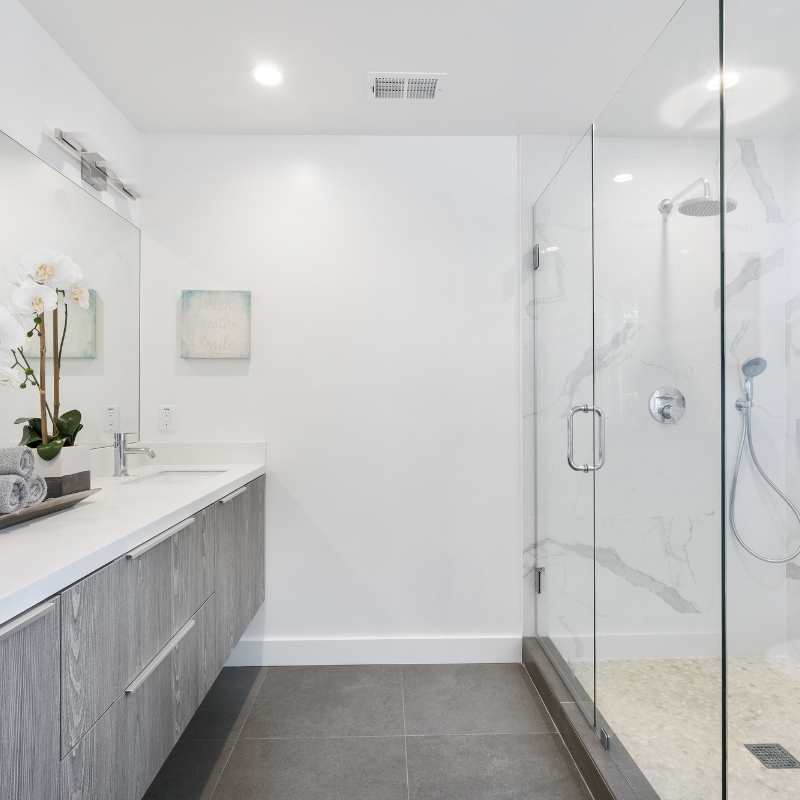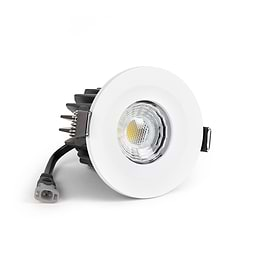How Many Downlights In The Bathroom?
How Many Downlights In The Bathroom?

Downlights make a great choice for a bathroom. Suitably IP rated they can be placed within the wettest areas of a bathroom such as the shower. They are great for task lighting where greater clarity is needed such as for applying makeup and shaving. Installed on a dimmer switch, this greater flexibility allows you to control the ambience as the role of the room changes throughout the day.
Whether you're refitting a bathroom or in the process of a complete renovation, you might be wondering how many downlights are the right amount for a bathroom. We explore this commonly asked question.
How Many Downlights In The Bathroom?
There is no standard answer as each bathrooms size and location differs. But it's a good idea to follow a few rules which you can apply to any bathroom.
Firstly, consider where the mirror is placed in the bathroom. Never place downlights directly above the mirror as the light distribution can make you look tired. Instead, place a downlight above and next to the mirror on either side. This will ensure that the light is evenly distributed across your face.
The downlights will disperse ample light positioning them close to the mirror. Ensure the light is angled onto the mirror, helping to reflect the light onto your face. You'll need tilted downlights to achieve this.
Time to get more technical. A bathroom contains 3 zones, and you'll need IP65 rated downlights if installing directly over a bath or shower. To calculate the number of downlights required in a bathroom you'll need to;
- Measure the square footage of the room by multiplying its width by its depth.
- Multiply this square footage by 1.5. This will give you a guideline for the total wattage required to light the space.
- Choose the downlights you require for the bathroom. Then identify the wattage of the downlights and use the total wattage you just calculated divided by the wattage of these downlights to work out how many are required.
When choosing the placement of the downlights, ensure they are roughly 1.5 to 2 ft. away from walls with a space of 3 to 4 feet between each light.
What Downlights Should I Use In The Bathroom?
There are many different types of downlights you can use in a bathroom - colour temperatures, CRI, dimmable, fixed and tilted. The first thing to take into consideration is that the bathroom is one of the rooms that warrants greater flexibility. You might need bright, precision lighting in the morning for applying makeup etc, but in the evening you want it to be dimmable so you can relax in an ambient setting.
High CRI downlights are a great choice for any bathroom including those with no natural light. The highest CRI levels provide the truest representation of colour. Providing precision and greater clarity for any tasks such as shaving, or applying makeup. These are especially good for a bathroom with no natural light as it provides the closest thing to natural daylight.
Dimmable downlights will give you a much greater control over the lighting setup. Just ensure you install a compatible dimmer switch with them for them to effectively function.
Being able to adjust colour temperature of the downlights is not a necessity. But if you want greater control over the ambience in your room then these could be the perfect downlights for your bathroom. This will allow you to opt for a brighter, white colour temperature for tasks in the morning and switch to a warm, orangey colour temperature for a relaxing, ambient soak in the bath.
How many downlights can I connect to one circuit?
This depends on the circuit's capacity and the wattage of each downlight. Depending on the type of switch you are using to operate these lights will dictate how many lights you can install on the same load. For standard rocker switches, it’s unlikely you will be installing enough downlights to even come close to the maximum wattage, especially in a bathroom. But this changes when using a dimmer to control your downlights.
If you are using 10W LED downlights, you could theoretically install up to 10 downlights on a 100W dimmer, however it is always best to allow some headroom for safety, as well as practical considerations like wiring, and voltage drop. For any installations, consult a qualified electrician to ensure compliance with wiring regulations.
Do I need fire-rated downlights in my bathroom?
Fire-rated downlights are designed to maintain the integrity of a ceiling in the event of a fire. When you cut holes for downlights, you compromise the fire resistance of the ceiling, potentially allowing flames and smoke to spread more quickly between floors. Fire-rated downlights have an intumescent material that expands when exposed to high temperatures, sealing the hole and restoring the ceiling's fire resistance for a specified period (typically 30, 60, or 90 minutes). This containment helps slow the spread of fire, giving occupants more time to evacuate safely.
Fire-rated downlights are typically required when installing downlights in ceilings that separate living spaces, such as between floors in multi-story homes or in apartments with neighbouring units above. Building regulations generally require that these ceilings maintain a certain level of fire resistance to prevent the rapid spread of fire. It’s always recommended to speak to a qualified electrician to help you understand what type of lighting you may need in your bathroom.
[related_products is_auto_added="1"]









